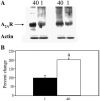Diminished iron concentrations increase adenosine A(2A) receptor levels in mouse striatum and cultured human neuroblastoma cells
- PMID: 19013457
- PMCID: PMC2784599
- DOI: 10.1016/j.expneurol.2008.10.007
Diminished iron concentrations increase adenosine A(2A) receptor levels in mouse striatum and cultured human neuroblastoma cells
Abstract
Brain iron insufficiency has been implicated in several neurological disorders. The dopamine system is consistently altered in studies of iron deficiency in rodent models. Changes in striatal dopamine D(2) receptors are directly proportional to the degree of iron deficiency. In light of the unknown mechanism for the iron deficiency-dopamine connection and because of the known interplay between adenosinergic and dopaminergic systems in the striatum we examined the effects of iron deficiency on the adenosine system. We first attempted to assess whether there is a functional change in the levels of adenosine receptors in response to this low iron. Mice made iron-deficient by diet had an increase in the density of striatal adenosine A(2A) (A(2A)R) but not A(1) receptor (A(1)R) compared to mice on a normal diet. Between two inbred murine strains, which had 2-fold differences in their striatal iron concentrations under normal dietary conditions, the strain with the lower striatal iron had the highest striatal A(2A)R density. Treatment of SH-SY5Y (human neuroblastoma) cells with an iron chelator resulted in increased density of A(2A)R. In these cells, A(2A)R agonist-induced cyclic AMP production was enhanced in response to iron chelation, also demonstrating a functional upregulation of A(2A)R. A significant correlation (r(2)=0.79) was found between a primary marker of cellular iron status (transferrin receptor (TfR)) and A(2A)R protein density. In conclusion, the A(2A)R is increased across different iron-insufficient conditions. The relation between A(2A)R and cellular iron status may be an important pathway by which adenosine may alter the function of the dopaminergic system.
Figures





Similar articles
-
Up-regulation of striatal adenosine A(2A) receptors with iron deficiency in rats: effects on locomotion and cortico-striatal neurotransmission.Exp Neurol. 2010 Jul;224(1):292-8. doi: 10.1016/j.expneurol.2010.04.004. Epub 2010 Apr 10. Exp Neurol. 2010. PMID: 20385128 Free PMC article.
-
Adenosine receptors as markers of brain iron deficiency: Implications for Restless Legs Syndrome.Neuropharmacology. 2016 Dec;111:160-168. doi: 10.1016/j.neuropharm.2016.09.002. Epub 2016 Sep 4. Neuropharmacology. 2016. PMID: 27600688 Free PMC article.
-
Novel 8-(furan-2-yl)-3-benzyl thiazolo [5,4-e][1,2,4] triazolo [1,5-c] pyrimidine-2(3H)-thione as selective adenosine A(2A) receptor antagonist.Neurosci Lett. 2011 Jan 13;488(1):1-5. doi: 10.1016/j.neulet.2010.08.006. Epub 2010 Aug 11. Neurosci Lett. 2011. PMID: 20708066
-
Evaluation of neuronal phosphoproteins as effectors of caffeine and mediators of striatal adenosine A2A receptor signaling.Brain Res. 2007 Jan 19;1129(1):1-14. doi: 10.1016/j.brainres.2006.10.059. Epub 2006 Dec 6. Brain Res. 2007. PMID: 17157277 Free PMC article.
-
Anatomy of adenosine A2A receptors in brain: morphological substrates for integration of striatal function.Neurology. 2003 Dec 9;61(11 Suppl 6):S12-8. doi: 10.1212/01.wnl.0000095205.33940.99. Neurology. 2003. PMID: 14663003 Review.
Cited by
-
Selective inhibition of hypoxia-inducible factor (HIF) prolyl-hydroxylase 1 mediates neuroprotection against normoxic oxidative death via HIF- and CREB-independent pathways.J Neurosci. 2009 Jul 8;29(27):8828-38. doi: 10.1523/JNEUROSCI.1779-09.2009. J Neurosci. 2009. PMID: 19587290 Free PMC article.
-
Targeting hypersensitive corticostriatal terminals in restless legs syndrome.Ann Neurol. 2017 Dec;82(6):951-960. doi: 10.1002/ana.25104. Epub 2017 Dec 7. Ann Neurol. 2017. PMID: 29171915 Free PMC article.
-
Deficiency of Meis1, a transcriptional regulator, in mice and worms: Neurochemical and behavioral characterizations with implications in the restless legs syndrome.J Neurochem. 2020 Dec;155(5):522-537. doi: 10.1111/jnc.15177. Epub 2020 Sep 23. J Neurochem. 2020. PMID: 32910473 Free PMC article.
-
Iron and restless legs syndrome: treatment, genetics and pathophysiology.Sleep Med. 2017 Mar;31:61-70. doi: 10.1016/j.sleep.2016.07.028. Epub 2016 Nov 10. Sleep Med. 2017. PMID: 28057495 Free PMC article.
-
Hyperactivity, dopaminergic abnormalities, iron deficiency and anemia in an in vivo opioid receptors knockout mouse: Implications for the restless legs syndrome.Behav Brain Res. 2019 Nov 18;374:112123. doi: 10.1016/j.bbr.2019.112123. Epub 2019 Jul 31. Behav Brain Res. 2019. PMID: 31376441 Free PMC article.
References
-
- Allen R. Dopamine and iron in the pathophysiology of restless legs syndrome (RLS) Sleep Med. 2004;5:385–391. - PubMed
-
- Allen RP, Barker PB, Wehrl F, Song HK, Earley CJ. MRI measurement of brain iron in patients with restless legs syndrome. Neurology. 2001;56:263–265. - PubMed
-
- Allen RP, Walter AS, Montplaisir J, Hening W, Myers A, Bell TJ, Ferini-Strambi L. Restless legs sysdrome prevalence and impact: REST general population study. Arch. Intern. Med. 2005;165:1286–1292. - PubMed
-
- Blum D, Hourez R, Galas MC, Popoli P, Schiffmann SN. Adenosine receptors and Huntington's disease: implications for pathogenesis and therapeutics. Lancet Neurol. 2003;2:366–374. - PubMed
-
- Bridges KR, Cudkowicz A. Effect of iron chelators on the transferrin receptor in K562 cells. J. Biol. Chem. 1984;259:12970–12977. - PubMed
Publication types
MeSH terms
Substances
Grants and funding
LinkOut - more resources
Full Text Sources
Medical

